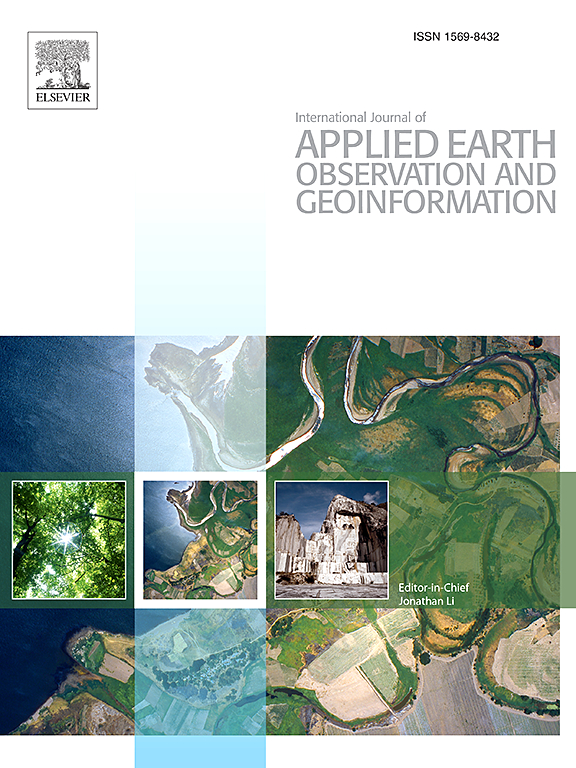探索客观特征与主观感知之间的功能区相关非线性关联:以北京为例
IF 7.6
Q1 REMOTE SENSING
International journal of applied earth observation and geoinformation : ITC journal
Pub Date : 2025-06-20
DOI:10.1016/j.jag.2025.104682
引用次数: 0
摘要
城市功能区既塑造了自然环境的形态,也塑造了个人感知城市空间和与城市空间互动的方式。然而,区域特定的客观特征(如绿色植物、交通信号灯)和主观感知(如美丽和无聊)之间的非线性关联仍未得到充分探索。本研究提出了一个分析框架,通过整合街景图像(SVIs)、全视分割和机器学习模型来研究中国北京的这种关联。具体而言,我们从svi中提取了9个客观特征和6个主观感知,并使用36个XGBoost模型结合SHAP分析对不同功能区的非线性关联进行了建模。模型性能稳健,与四个基线机器学习模型相比,XGBoost实现了最高的平均R2(0.221)和最低的平均RMSE值(0.031)之一,强调了其在感知维度和功能区类型上的通用性。研究结果揭示了三个关键发现。首先,道路使用者和安全屏障一直是所有功能区主观感知的最大贡献者,而交通标志等元素则表现出区域特定的影响。非线性关联在不同功能区表现出不同的阈值效应,突出了环境因素的情境依赖性影响;例如,绿化能见度降低了住宅区的安全感,但提高了商业区的安全感。第三,观察到典型的非线性模式,包括v形效应和阈值效应,反映了感官饱和和边际效用递减等现象。这些发现有助于更深入地理解城市形态与人类感知之间的复杂动态关系,为适应性、以人为中心的城市设计策略提供见解。本文章由计算机程序翻译,如有差异,请以英文原文为准。
Exploring functional zone-dependent nonlinear associations between objective features and subjective perceptions: A case study in Beijing
Urban functional zones shape both the configuration of the physical environment and the ways individuals perceive and interact with urban spaces. However, the nonlinear associations between zone-specific objective features (e.g., greenery, traffic lights) and subjective perceptions (e.g., beauty and boredom) remain underexplored. This study proposes an analytical framework to investigate such associations in Beijing, China, by integrating street view images (SVIs), panoptic segmentation, and machine learning models. Specifically, we extracted nine objective features and six subjective perceptions from SVIs and modeled their nonlinear associations across different functional zones using 36 XGBoost models combined with SHAP analyses. Model performance was robust, with XGBoost achieving the highest average R2 (0.221) and one of the lowest average RMSE values (0.031) compared to four baseline machine learning models, underscoring its generalizability across perception dimensions and functional zone types. The results reveal three key findings. First, road users and safety barriers consistently ranked among the top contributors to subjective perceptions across all functional zones, while elements like traffic signs exhibited zone-specific effects. Second, the nonlinear associations exhibited varying threshold effects across functional zones, highlighting the context-dependent influence of environmental factors; for example, greenery visibility reduced safety perception in residential zones but enhanced it in commercial zones. Third, typical nonlinear patterns, including V-shaped and threshold effects, were observed, reflecting phenomena such as sensory saturation and diminishing marginal utility. These findings contribute to a deeper understanding of the complex dynamics between urban form and human perception, offering insights for adaptive, human-centric urban design strategies.
求助全文
通过发布文献求助,成功后即可免费获取论文全文。
去求助
来源期刊

International journal of applied earth observation and geoinformation : ITC journal
Global and Planetary Change, Management, Monitoring, Policy and Law, Earth-Surface Processes, Computers in Earth Sciences
CiteScore
12.00
自引率
0.00%
发文量
0
审稿时长
77 days
期刊介绍:
The International Journal of Applied Earth Observation and Geoinformation publishes original papers that utilize earth observation data for natural resource and environmental inventory and management. These data primarily originate from remote sensing platforms, including satellites and aircraft, supplemented by surface and subsurface measurements. Addressing natural resources such as forests, agricultural land, soils, and water, as well as environmental concerns like biodiversity, land degradation, and hazards, the journal explores conceptual and data-driven approaches. It covers geoinformation themes like capturing, databasing, visualization, interpretation, data quality, and spatial uncertainty.
 求助内容:
求助内容: 应助结果提醒方式:
应助结果提醒方式:


